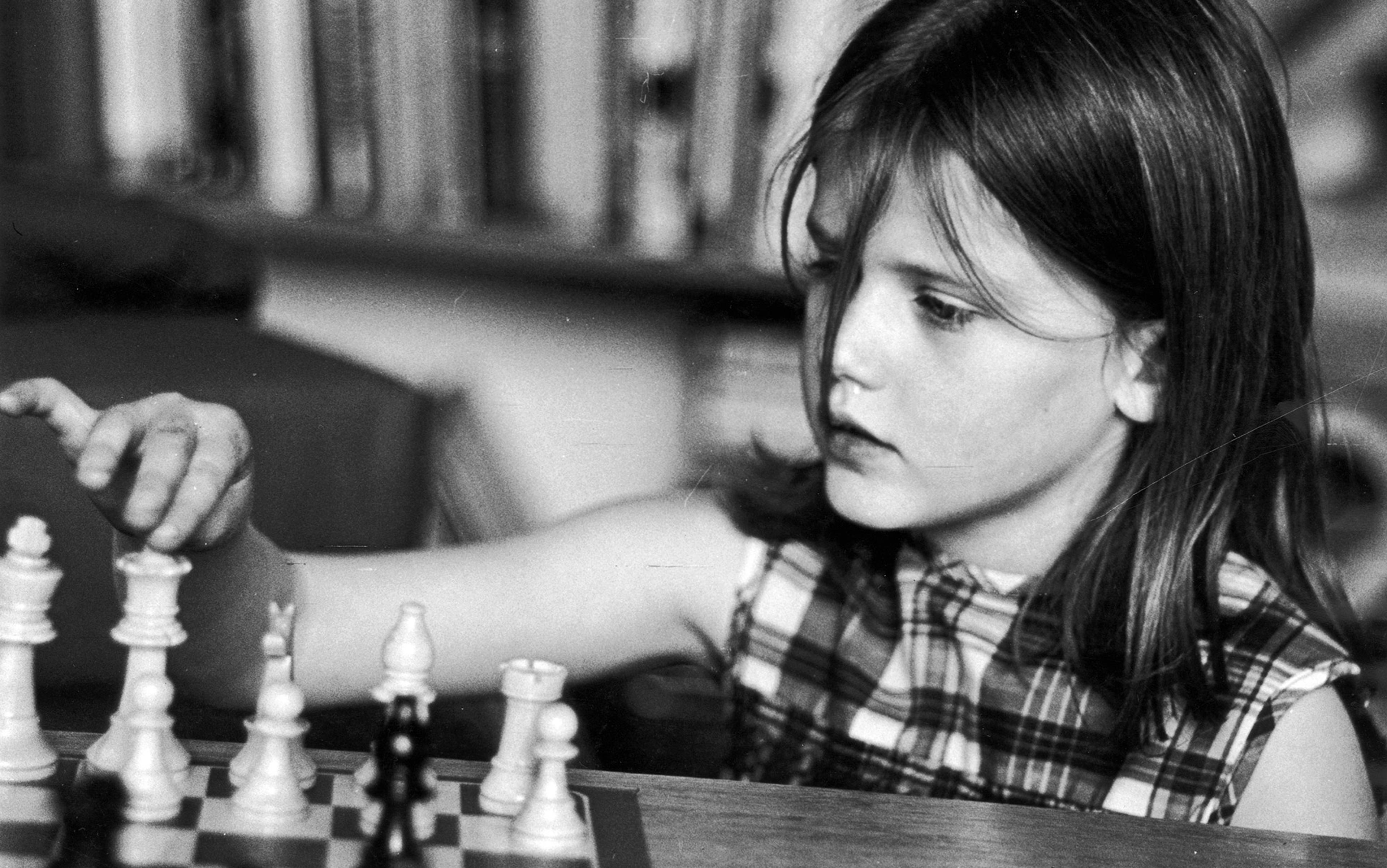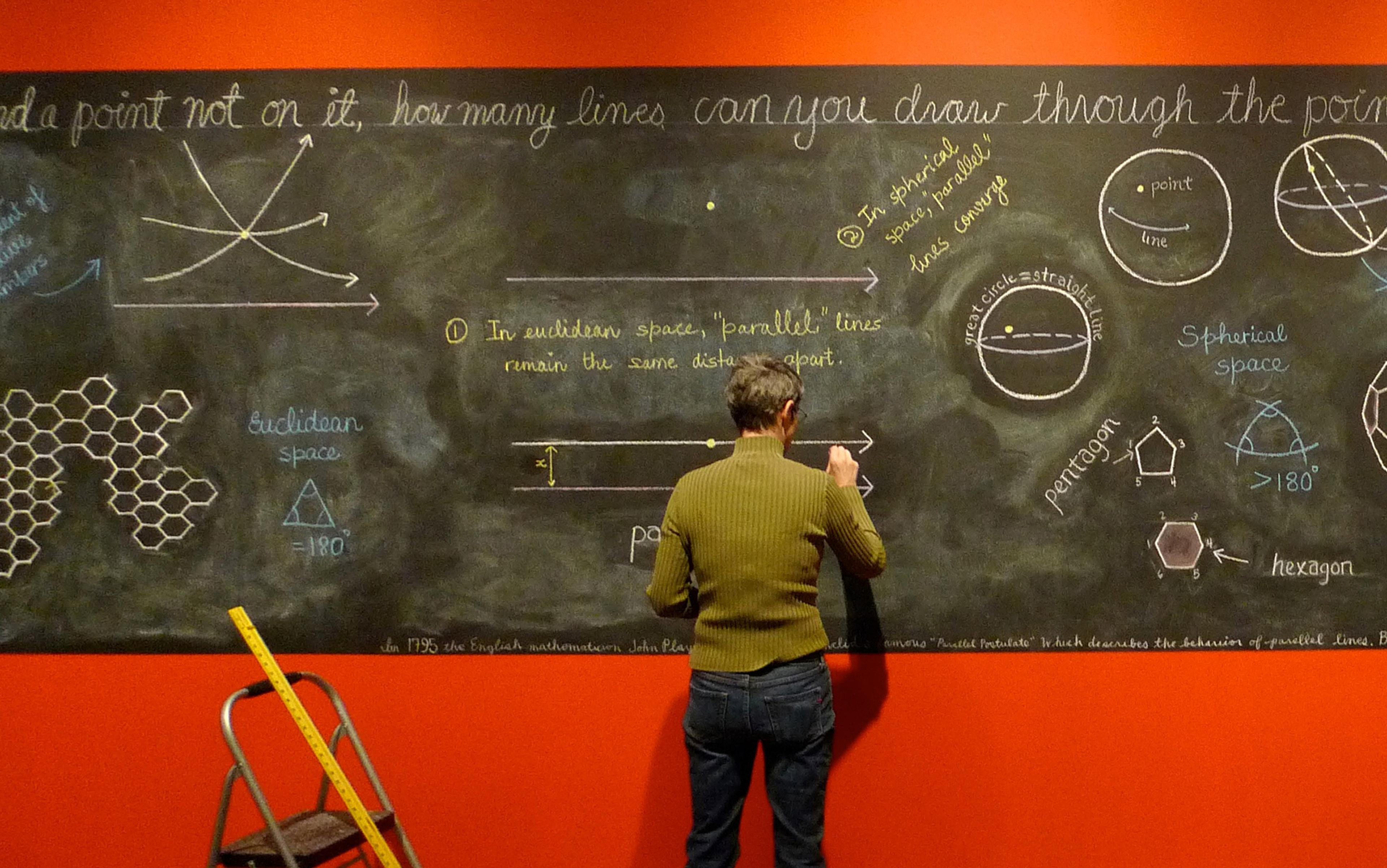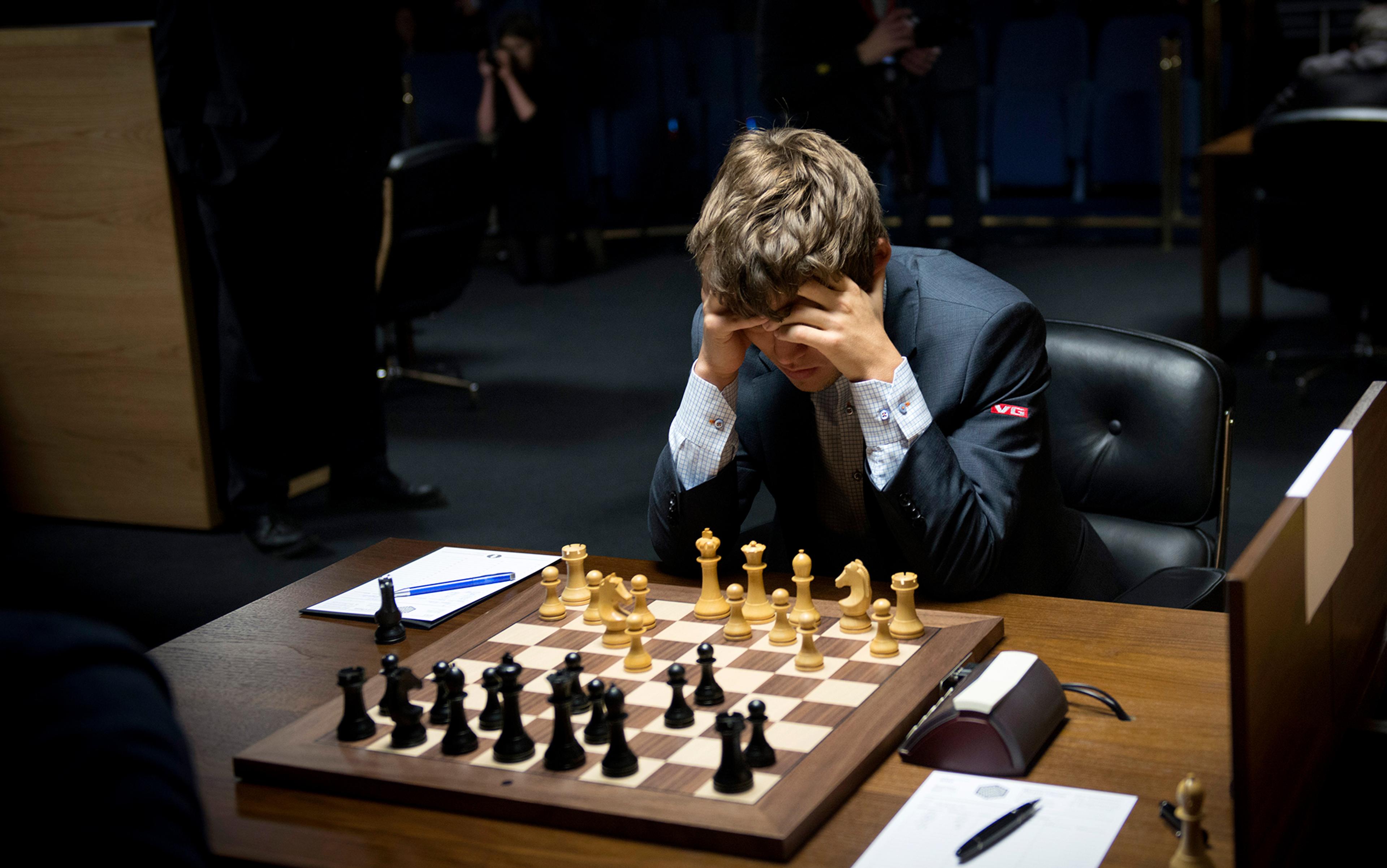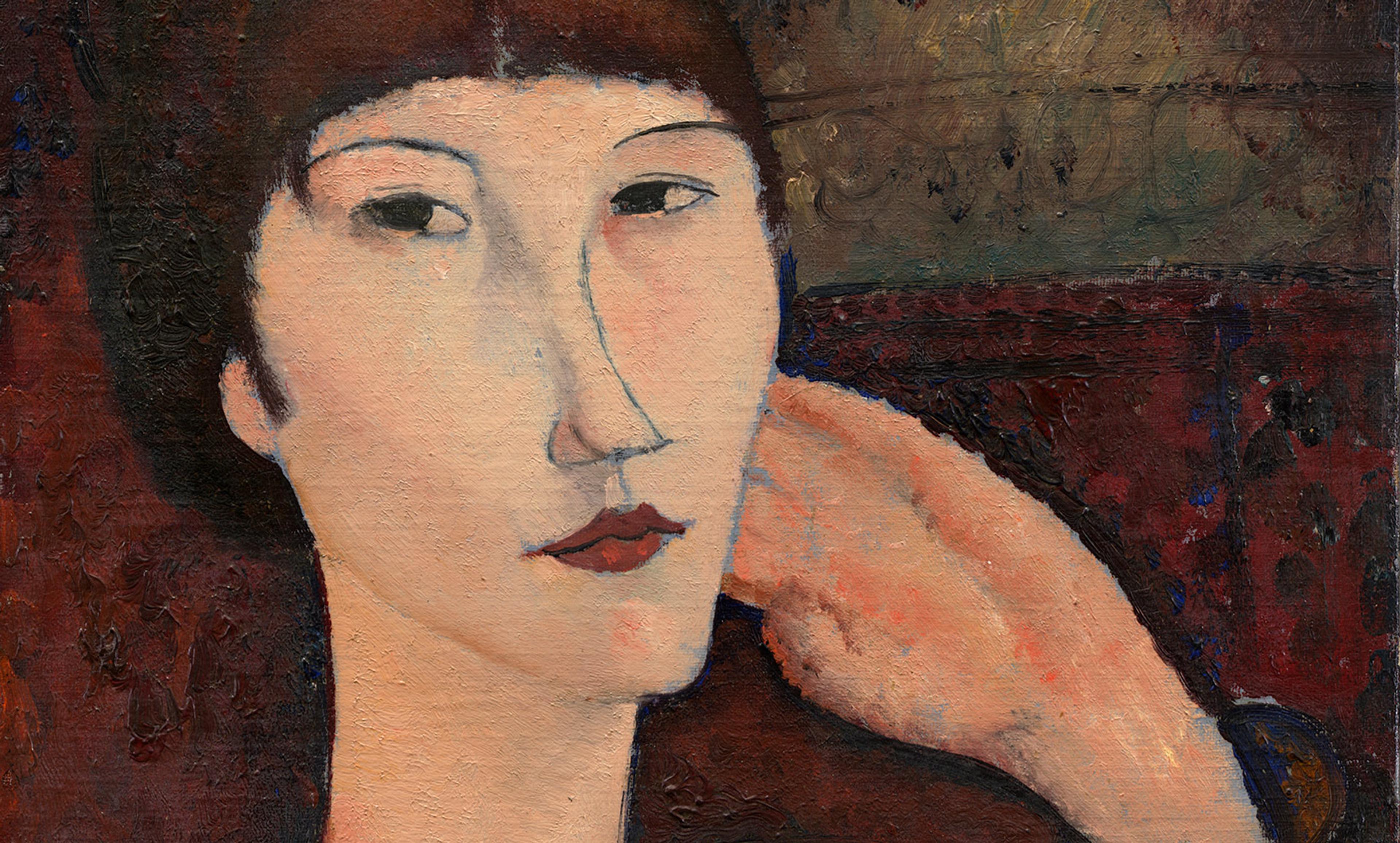Here’s a story my father likes to tell. When I was five, my family spent several months living in Barbados. Since we were in a rental house, there weren’t many games or toys around, save for the beat-up travel checkers set we’d packed in our suitcase. The hours I didn’t spend in school learning to add a ‘u’ to the word color, or inspecting shells on the beach, I spent playing checkers, first with my family, and then, when they got sick of it, with the visitors who straggled through our cinderblock bungalow. One of them, a computer science professor, thought he’d humour my parents by playing with their sunburned kid. I destroyed him in two games. ‘I told you she was good,’ said my father. ‘Yes,’ said the professor, ‘but the second game I was trying.’
I don’t remember this particular instance because it was unremarkable. I destroyed lots of people in checkers. The game turned out to be my gateway drug, and soon I began playing chess. Chess didn’t have the speed of checkers or the satisfying click the pieces made when you snapped one on top of the other and whispered: King me, but I liked that it had a story and characters and the ability to come back from near‑annihilation in a few swift moves. So when my school offered a chess club in fourth grade, I promptly signed up.
That first day we learned two endgame strategies. This was a whole new window onto the game: it was not a series of random moves, but rather the application of an already-established pattern. One merely needed to recognise the pattern, apply the strategy, set the trap and… checkmate. I was so dazzled by the idea of an endgame, even by the very word endgame with its connotations of finality and apocalypse, that it took me until the third week to notice that I was the only girl in chess club.
That was in 1980, and one might imagine that in the past 35 years the world has changed significantly vis-à-vis girls and chess, but one would be wrong. As of May 2015, there are only two women who rank in the top-100 chess players worldwide. The United States Chess Federation states on its website that it has 85,000 members who are ‘predominantly male’. Scanning the ‘sex’ column on the World Chess Federation’s list of grandmasters is like reading a statistical overview of the men’s and women’s bathroom lines at a tech conference – of 1,479 grandmasters, 31 are women. That’s two per cent. Where are all the women chess players?
Chess wasn’t always a male domain. In Birth of the Chess Queen (2004), the historian Marilyn Yalom describes a long line of female chess players stretching back through the centuries. In medieval Spain, women played chess in bed while recovering from childbirth. A French tale from 1230 tells of a knight who must win against an emir’s chess-master daughter in order to earn her hand. A school in 15th-century Germany, founded by a chess-loving bishop, taught girls and boys the game as part of the curriculum.
Then, around the turn of the 17th century, women abruptly dropped out of the chess scene. Yalom hypothesises that this could have been related to changes in the game: the queen and bishop, both formerly weak pieces with limited movement, were now allowed to swoop terrifyingly across the board and dominate. Chess went from a leisurely game played between lords and ladies to a cut-throat competitive sport played in public houses and cafés, and therefore considered an unseemly activity for women.
Whatever the reason, polite society has been murmuring the same message for more than 300 years: chess is not for women and, moreover, women are innately bad at it. In 1897, an article in American Chess Magazine noted that women’s chess games were subject to ‘illogical aberrations’ and suggested that the cause could be wire hairpins. In 1906, Lasker’s Chess Magazine explained the lack of female chess superstars as a natural outcome given women’s general lack of ‘qualities of concentration, comprehensiveness, impartiality and, above all, a spark of originality’. Chessworld’s 1964 spring issue featured an article by Norman Reider entitled ‘The Natural Inferiority of Women Chessplayers’. The US chess grandmaster Bobby Fischer was full of explanations for women’s chess shortcomings, most famously this one: ‘They’re all weak, all women. They’re stupid compared to men. They shouldn’t play chess, you know. They’re like beginners.’ This, from a man whose sister taught him to play the game.
Lest these opinions be dismissed as old-fashioned, or the misogynist rantings of a madman, the most recent comment in this vein came just this April from the UK grandmaster Nigel Short, who encourages us to ‘gracefully accept it as a fact’ that men are simply ‘hardwired’ to be better chess players. Short was pummelled in the British press for his remarks; Twitter users wanted to know what to make of the fact that he’d been beaten by the Hungarian grandmaster Judit Polgár. But in his defence, Short was merely echoing something men have been saying for more than 100 years, his argument buoyed by the study ‘Explaining male predominance at the apex of intellectual achievement’ (2013).
A solid explanation, Howard concludes, is that men are innately better at chess than women
This study, by the psychologist Robert Howard, then at the University of New South Wales in Sydney, compares male and female performance in international chess, and finds that men consistently perform better than women, even when there are more women chess players. Howard claims that by looking only at top players, his study eliminates the issues of ‘glass ceilings and male gatekeepers downplaying female achievement’, as though these issues can be simply dismissed once a woman makes it to the upper echelons of the chess world. Howard also points out that in Georgia, a former-Soviet republic where 30 per cent of chess players are women, the performance gap still exists, though less so. A solid explanation, Howard concludes, is that men are innately better at chess than women.
Howard has been conducting studies on the topic of male intellectual dominance for the past 10 years. His publications read like the reading list for a men’s empowerment club, with titles such as ‘Are gender differences in high achievement disappearing?’ (2005) – not according to Howard – and ‘Gender differences in intellectual achievement persist at the limits of individual capabilities’ (2013) – ie men are smarter. But whatever Howard’s motivation, his study was an attempt to discredit the prevailing explanation for why there are so few women chess players at the top, which is that there are so few girls at the bottom.
To this day, the number of parents who sign up their sons for chess lessons dwarfs the number of those who sign up their daughters. I studied the participant list at a recent elementary school-aged chess tournament that my kids played in on Manhattan’s Upper West Side, and found that boys outnumbered girls five to one. The NYChessKids programme, which runs classes throughout New York City, reports that while girls make up about half of their classes for preschoolers through to third grade, when it comes to tournaments, girls make up a quarter of players at most.
One of those girls, at the moment, is my daughter, who has come to love the game through her chess-obsessed older brother. I’d always assumed my kids would learn the game just as I had, and I’d intended to start them out with checkers. When my son was three, I brought home a chess and checkers set, because if I had to play one more game of Candy Land I thought I might implode. I attempted to interest him in checkers, but he wanted to play only with the chess pieces. He was swept up in a love for the game before he even understood what the game was. He spent hours pretending to be chess pieces (you really haven’t fully experienced the glory of parenthood until you’ve watched your white three-year-old son run down a crowded street yelling ‘I’m a black queen!’), and began taking chess lessons at four.
Our breakfast conversations sometimes include the phrase en passant and mentions of the Sicilian defence. It was into this environment that my daughter was born. She quickly grasped that there was something precious and holy about the black and white wooden pieces her brother spent so much time with – for several months of preschool she insisted on bringing a ‘pet’ rook on a leash to school with her – and eventually he taught her the game so he’d have a willing opponent at all times.
So it was jarring to witness her, now six, marching into her first tournament surrounded by boys. Indeed, it wasn’t until I saw her blonde head bobbing in a sea of close-cropped hair that all those percentages began to mean something. The chess teachers and chess clubs I spoke with all report that, while the number of girls who start playing chess is increasing, and the percentage of females who are members of the US Chess Federation is at an all-time high, girls still tend to drop out at a furious pace.
Some of that might be due to something called stereotype threat. In a 2013 study, the US psychologists Hank Rothgerber and Katie Wolsiefer found that girls as young as six are aware of the stereotype that ‘good chess players are usually boys’. Even worse, awareness of the stereotype affects the way girls play. The psychologists analysed data from 12 chess tournaments, and calculated expected winning percentages for different pairings. Because chess players are all rated by the US Chess Federation, this is a simple calculation to make – a player with a 1000 rating is going to get smoked by a player rated at 2000, but has a fighting chance against one who is at 1100. Rothgerber and Wolsiefer found that when girls played against boys who presented a strong or moderate challenge, they lost more than they should have.
Stereotype threat isn’t confined to kids. In a 2008 study, researchers at the University of Padua in Italy matched 42 expert female chess players with similarly ranked male opponents online. When the women weren’t told the gender of their opponent, or were told (incorrectly) that they were playing against another woman, they performed as expected. When they were told their opponent was male, they played dramatically worse. Which could partially explain why girls are quick to quit. If somewhere back in the recesses of your brain you believe that girls aren’t naturally gifted at chess, then working to improve at the game would be an exercise in futility.
‘By middle school, boys get very aggressive vocally. Girls don’t like it’
Stereotype threat is only one possible reason girls quit. One chess teacher I spoke with said that he’s had several female students with great potential quit in favour of more traditionally girl-approved activities such as horse riding and ice skating. Gary Ryan, the Vice President of NYChessKids, said he’s noticed that girls can also be put off by the hyper-competitive atmosphere that tends to develop in the tween years.
‘When they’re young, boys and girls both love chess,’ says Ryan. ‘But by middle school, boys get very aggressive vocally, like trash talking. Boys almost do that all the time. Girls don’t like it and aren’t into it.’
The aggression could begin even earlier. I recently observed my daughter playing against a slightly older boy at a chess tournament. Whenever he took a piece, he crashed the figure onto the board, the pieces making a loud clicking noise as though one had broken the other’s neck, then swooped up the conquered piece and slammed it down to the side of the board. Watching the game, I had to stifle the urge to shove a bishop up his nose. To her credit, my daughter brushed off the aggression, but I couldn’t help but wonder how long that will last. You’d have to be a pretty strong-willed teenage girl to handle being the only female in a room full of hormone-addled, trash-talking boys smashing knights and rooks around a chess board.
And for those girls who have made it through the elementary-school years and into the more competitive chess world of middle and high school, even larger hurdles loom. Susan Polgár, sister of Judit and the world’s first female grandmaster, pointed out when we spoke recently that girls suffer from a Catch-22 when they begin to play chess more competitively. Because there are very few women at the upper levels of chess, there are very few female chess coaches. And because there are very few female chess coaches, there are very few girls who manage to make it to the next level in chess.
The lack of women coaches presents two challenges. First, there’s a logistical issue. Coaches typically spend long hours with their protégées, and many parents aren’t comfortable letting their teenage daughters hang out with some guy playing chess all day. Things get more complicated once coaches start to travel with players to tournaments, and logistical issues around hotel rooms and long weekends away from home crop up. Polgár also notes the economic issue: male coaches need a separate room from their female players, which doubles travel costs.
But beyond the discomfort factor, Polgár also believes that boys and girls need to be coached differently, and that male coaches might find it difficult to understand a young girl’s mindset.
‘Boys are a lot more competitive naturally, so you don’t need to teach them to be competitive,’ she says. ‘Girls need to be coached to be more competitive.’
When people talk about how girls aren’t suited to chess, one of the first things they point out is that boys are supposedly more competitive or aggressive than girls. Nigel Short, before he announced that women weren’t wired to play chess, said they ‘just don’t have the killer instinct’.
But there is a difference between being competitive and being aggressive. Multiple studies have shown that men are more physically and verbally aggressive than women, but studies around competitiveness have been inconclusive. And as anyone who survived middle school can attest, the world doesn’t lack for girls who like to win. I was curious about Susan Polgár’s assertion, so I asked Alexander Rasic, my son’s chess teacher and a man with more than 30 years’ coaching experience, whether girls needed to be taught to be competitive. He told me the following story:
I have two daughters. One came out of her first chess tournament holding hands with the kid she’d been playing against. She said they’d decided to make it a tie and be friends. My other daughter, she’d beat her own grandmother.
Killer instinct aside, studies have shown that men and women do have different styles of playing. A 2010 study found that, when a man is playing a woman, he’s likely to become even more aggressive than when he plays another man. Researchers at Stockholm University discovered that when strong male players were paired with strong female players, the men were more likely to open with an overly aggressive set of moves, which in the long run is a riskier and, the paper points out, ‘irrational’ strategy. And this difference shows up in kids too. Gary Ryan says the girls he’s taught tend to have a more subtle, less aggressive style of play, which indicates that they likely do need to be coached differently from boys.
The prize money for the Women’s World Chess Championship is less than a third of the prize money for the World Chess Championship
But regardless of coaching, studies show that the primary indicator of whether someone will become a good chess player is the level of interest in becoming a good chess player. Chess is a sport that requires hours of practice and study. And here is where girls and women face yet another hurdle. In order to want to succeed at something, there needs to be a strong motivating factor. For players who want to go pro, the incentives for men and women differ dramatically. The prize money for the Women’s World Chess Championship is less than a third of the prize money for the World Chess Championship. And, backing up for a moment, yes, there is a Women’s World Chess Championship.
When I first heard that this existed, I wondered, absurdly, if there was something about chess that I’d been missing all these years that would require such a division. Were the pieces very heavy? Was there, in fact, something about women and chess that would require them, tennis-like, to compete separate from their male counterparts? It turns out that the division hasn’t been without controversy. The women’s championship is open only to women; the World Chess Championship, which is now open to men and women, is often referred to as the men’s championship. That’s because up until 1986 it was the Men’s World Chess Championship, a title that was cited as the reason for barring the first woman to qualify from competing in the tournament. (That woman was Susan Polgár.)
Jennifer Shahade, a two-time US Women’s Chess Champion and the author of Chess Bitch (2005) and Play Like a Girl (2011), takes offence at the idea that there is anything wrong with women’s tournaments.
‘It’s not like women’s chess tournaments are an admission of inferiority, like women are saying we’re stupid so we’re playing in them,’ Shahade told me. But once chess players reach a certain level, it’s hard not to see the Women’s Chess Championship as the poor stepsister to the real action. The Women’s winner always ranks lower than the World Champion winner. Judit Polgár, the highest ranking woman in chess history, has refused to play in women’s tournaments throughout her career. Perhaps she hasn’t needed to. She’s defeated plenty of boldface chess names, including Garry Kasparov, Boris Spassky and Magnus Carlsen. She has also argued that, when girls play only against other girls, they end up limiting themselves and their ability to improve.
Setting aside all the hurdles, why is it important that girls, and women, play chess? I could point to studies showing that playing chess improves reading scores and emotional intelligence. But there are also studies showing that playing chess has little impact on areas outside of chess. When parents sign up kids for lessons with Rasic, they’ll often ask which academic subjects they can expect their child to excel at. He tells them that he can’t guarantee that they’ll see improved academic performance; all he can guarantee is that their child will get better at chess.
There might not be a direct correlation between playing chess and academic excellence, but there is undoubtedly a benefit to young girls learning that they can compete on the same intellectual playing field as boys. The opportunity to overcome stereotype threat is important practice for girls who might want to go into other fields rife with stereotypes about women, or simply as an opportunity to perform well when no one expects you to do so.
And faith in one’s intellectual abilities can go a long way towards overcoming the soul-rattling feeling of being the only girl in the room, whether it’s at a chess tournament, or in a computer science class. It’s important that girls learn how to occupy space, and ultimately excel, in arenas that are typically viewed as too aggressive and competitive for the ladies. I work in technology, and the sinking feeling I had as I counted the number of girls at that recent chess tournament was nearly identical to the sinking feeling I’d had a year earlier at a pitch session for tech companies seeking funding.
Every time my daughter notices a lack of girls or women in a field (her soccer club, the presidency, the Brooklyn Nets basketball team), we both experience an awkward moment of silence: a twinge like a paper cut for me, a reassessing of the world for her. I want her to grow up believing that girls can be anything, but the world often trumps my hand.
Susan Polgár says change is coming, but it will be slow. She is retired from professional chess and runs a foundation aimed at fostering girls in the chess world. Any changes are too late for me. A week after discovering I was the only girl in my fourth-grade chess club, I quit. Since 1980, I’ve played only a handful of games. Today, even though chess is often being played in my house, I’m never a part of it. I relish playing all sorts of other smash-your-opponent types of games with my kids but I was never able to find my way back to chess. Instead, I watch my children make their way through that world, competition clocks and notebooks at their sides, and I keep an eye on my daughter. For now she’s happy to play against the boys. But the odds aren’t on her side.






